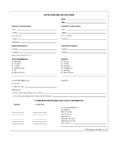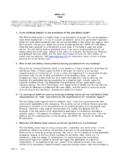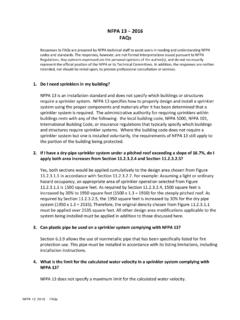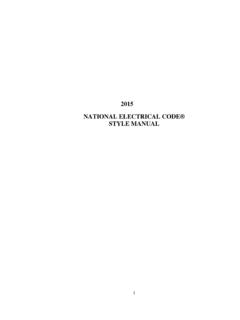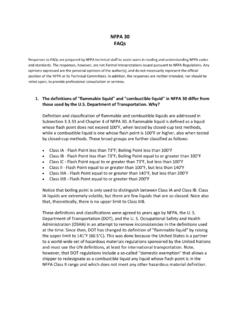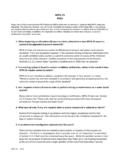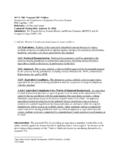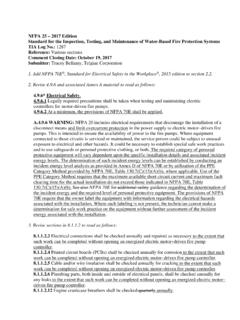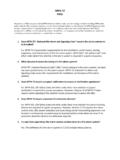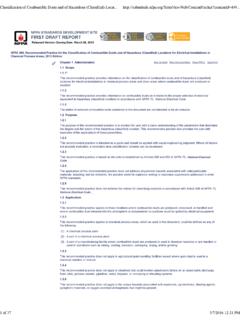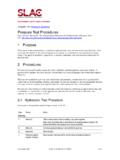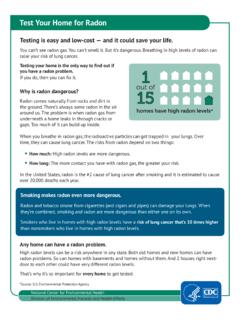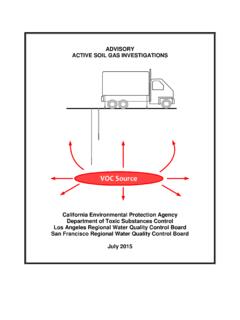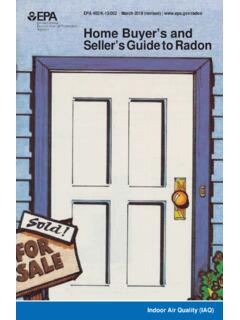Transcription of NFPA 54, NATIONAL FUEL GAS CODE
1 What nfpa 54 CoversNFPA 54, NATIONAL fuel Gas code , is the American NATIONAL Standard (ANSI ) that applies to the installation of fuel gas piping systems, equipment, and appliances that are supplied with natural gas, manufactured gas, liquefied petroleum gas (LP-Gas) in the vapor phase only, LP-Gas air mixtures, mixtures of these gases, and gas air mixtures in the flammable code does not apply to natural gas systems operating at pressures over 125 psi (862 kPa), propane systems operating at pressures over 50 psi (345 kPa), or gas air mixtures operating within the flammable range at pressures over 10 psi (69 kPa). nfpa 54 addresses the following: Piping system design, materials, and components, including valves, expansion, and flexibility (Chapter 5) Piping sizing for applications via tables and equations (Chapter 6) Installing pipes, outlets, and inside concealed spaces (Chapter 7) Requirements for process air, installation of appliances, and safety shutoffs (Chapter 9) Minimum safe performance, general requirements, and specifications for venting (Chapter 12) When to Use nfpa 54 The exhibit below shows how nfpa 54 interacts with other requirements.
2 The split (jurisdiction division) between nfpa 58 and nfpa 54 is shown at the point of delivery of a typical propane supply. The split between nfpa 54 and federal pipeline regulations (49 CFR 192) is shown at the point of the delivery of a typical natural gas supply. In most cases only one gas supply will serve a building; however, nfpa 54 does not prohibit the use of more than one fuel gas in a SHEETNFPA 54, NATIONAL fuel GAS CODEF inished ground levelFrom gas mainMeterNFPA 5849 CFR 192 nfpa 54 nfpa 54 is not intended to be applied retroactively, unless the government body adopting the code requires retroactivity. Any equipment or system complying with the code at the time of installation can be maintained in use as long as the equipment is not changed YOU KNOW? nfpa 54, NATIONAL fuel GAS code CONTINUED TMThis material contains some basic information about nfpa 54, NATIONAL fuel Gas code . It identifes some of the requirements in these documents as of the date of publication.
3 This material is not the official position of any nfpa Technical Committee on any referenced topic which is represented solely by the nfpa documents on such topic in their entirety. For free access to the complete and most current version of all nfpa documents, please go to While every effort has been made to achieve a work of high quality, neither the nfpa nor the contributors to this material guarantee the accuracy or completeness of or assume any liability in connection with this information. Neither the nfpa nor the contributors shall be liable for any personal injury, property, or other damages of any nature whatsoever, whether special, indirect, consequential, or compensatory, directly or indirectly resulting from the publication, use of, or reliance upon this material. Neither the nfpa nor the contributors are attempting to render engineering or other professional services. If such services are required, the assistance of a professional should be sought.
4 2020 NATIONAL Fire Protection Association / May 2020 FACT SHEET FAQsWhat are some of the major changes to the code for 2021?Changes for the 2021 edition of nfpa 54 include the following: Engineering methods have been defined to provide users with requirements on what qualifies as an engineering method. Requirements for venting of pressure control devices, such as line pressure regulators, gas appliance regulators, and gas pressure limit controls, have been standardized to provide a singular reference for those installing such devices. Point of delivery is defined in Chapter 3 to provide more accurate enforcement of requirements that relate to the point of delivery. A section on electrical isolation has been added to specify dielectric fittings are to be installed on underground metallic piping at building penetrations but not under ground in order to electrically isolate the house for corrosion purposes and keep the dielectric fitting accessible for maintenance.
5 Through-the-wall vent terminal clearances have been revised to coordinate with applicable ANSI appliance standards as well as provide requirements for commonly encountered scenarios so that designers and builders can have one reference for vent terminal nfpa 54 for the complete language of these and other gas detectors required in spaces where fuel gas piping or appliances are installed? nfpa 54 requires combustible gas detectors or indicators to be used when purging fuel lines or to locate a leak during pressure testing of new or modified gas piping systems, but they are not required to be permanently located in any spaces. nfpa currently is developing nfpa 715, Standard for the Installation of fuel Gases Detection and Warning Equipment, to provide requirements for safe installation of fuel gas detectors. When completed, this standard will then be used in conjunction with fire and building codes to potentially determine spaces where fuel gas detectors will be can information on required clearances for a specific appliance be found?
6 Listed appliances have a label attached to the appliance that describes required clearances. The manufacturer s instructions will also have this information. Chapter 10 of nfpa 54 provides clearances for some types of unlisted does gas piping need to have a separate bonding connection?Gas piping does not require a separate bonding connection unless one of the following situations occurs: Where there are gas appliances with electrical connections that are connected to ungrounded wiring systems ( , two-pronged plugs) Where there are sources of high-voltage electricity outside the piping system that could energize the gas piping system (highly unusual or unlikely) Where the gas piping material is CSSTWhat does nfpa 54 not cover? nfpa 54 does not apply to portable LP-gas appliances and equipment of all types that are not connected to a fixed fuel piping system; LP-Gas installations at utility gas plants; fuel gas piping in electric utility power plants; gas piping, meters, gas pressure regulators, and other appurtenances used by the serving gas supplier in distribution of gas, other than undiluted LP-Gas; or construction of appliances.
7 See of the code for a list of applications that nfpa 54 does not More InformationVisit for more nfpa 54 related information, including free access to the full text of the to learn more about the 2021 edition of nfpa 54, as well as the NATIONAL fuel Gas code Handbook, which pairs the complete code text with exhibits, features, and in-depth explanations of requirements from experts in the to learn more from industry experts and join the conversation on nfpa Xchange.
